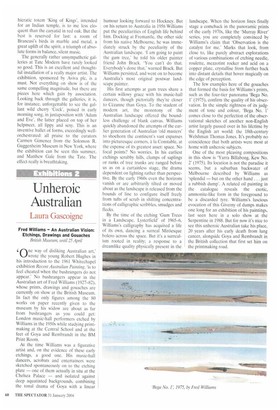Unheroic Australian
Laura Gascoigne
Fred Williams An Australian Vision: Etchings, Drawings and Gouaches British Museum, until 25 April
(-1 n e way of disliking Australian art,' k_lwrote the young Robert Hughes in his introduction to the 1961 Whitechapel exhibition Recent Australian Painting, 'is to feel cheated when the bushrangers do not appear.' No bushrangers appear in the Australian art of Fred Williams (1927-82), whose prints, drawings and gouaches arc currently on show at the British Museum. In fact the only figures among the 80 works on paper recently given to the museum by his widow are about as far from bushrangers as you could get: London music-hall performers etched by Williams in the 1950s while studying printmaking at the Central School and at the feet of Goya and Rembrandt in the BM Print Room.
At the time Williams was a figurative artist and, on the evidence of these early etchings, a good one. His music-hall dancers, acrobats and entertainers were sketched spontaneously on to the etching plate — one of them actually in situ at the Chelsea Palace — and isolated against deep aquatinted backgrounds, combining the tonal drama of Goya with a linear humour looking forward to Hockney. But on his return to Australia in 1956 Williams put the peculiarities of English life behind him. Docking at Fremantle, the other side from his native Melbourne, he was immediately struck by the peculiarity of the Australian landscape. 'I am going to paint the gum tree,' he told his older painter friend John Brack, 'You can't do that. Everybody's done that,' warned Brack. But Williams persisted, and went on to become Australia's most original postwar landscape painter.
His first attempts at gum trees share a certain willowy grace with his music-hall dancers, though pictorially they're closer to Cezanne than Goya. To the student of modern art, the monotony of the Australian landscape offered the boundless challenge of blank canvas. Williams quickly abandoned the attempts of the earlier generation of Australian 'old masters' to shoehorn the continent's vast expanses into picturesque corners, a la Constable, at the expense of its greatest asset: space. No focal points? No worries. In his earliest etchings scrubby hills, clumps of saplings or ranks of tree trunks are ranged before us as on a curtainless stage, the drama dependent on lighting rather than perspective. By the early 1960s even the horizons vanish or are arbitrarily tilted or moved about as the landscape is released from the bounds of line to configure itself freely from tufts of scrub in shifting concentrations of calligraphic scribbles, smudges and flecks.
By the time of the etching 'Gum Trees in a Landscape. Lysterfield' of 1965-6, Williams's calligraphy has acquired a life of its own, dancing a surreal Miroesque bolero across the space. But it's a surrealism rooted in reality; a response to a dreamlike quality physically present in the landscape. When the horizon lines finally stage a comeback in the panoramic prints of the early 1970s, like the 'Murray River' series, you are completely convinced by Williams's claim that 'Observation is the catalyst for me.' Marks that look, from close to, like purely abstract explorations of various combinations of etching needle, roulette, mezzotint rocker and acid on a copper plate, crystallise from further back into distant details that hover magically on the edge of perception.
The few examples here of the gouaches that formed the basis for Williams's prints, such as the four-tier panorama `Bega No.
1' (1975), confirm the quality of his observation. In the simple rightness of its judgment of tone and colour, `Bega No. 1' comes close to the perfection of the observational sketches of another non-English artist largely passed over in his lifetime by the English art world: the 18th-century Welshman Thomas Jones. It's probably no coincidence that both artists were most at home with unheroic subjects.
One of the most pleasing compositions in this show is `Yarra Billabong, Kew No.
2' (1975). Its location is not the paradise it seems, but a suburban backwater of Melbourne described by Williams as 'splendid — but on the other hand. . . just a rubbish dump'. A related oil painting in the catalogue reveals the exotic, ammonite-like form in the foreground to be a discarded tyre. Williams's luscious evocation of this Givemy of dumps makes one long for an exhibition of his paintings, last seen here in a solo show at the Serpentine in 1988. But for now it's nice to see this unheroic Australian take his place, 20 years after his early death from lung cancer, alongside Goya and Rembrandt in the British collection that first set him on the printmaking road.




























































































 Previous page
Previous page